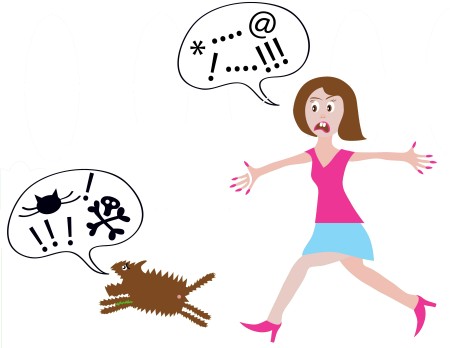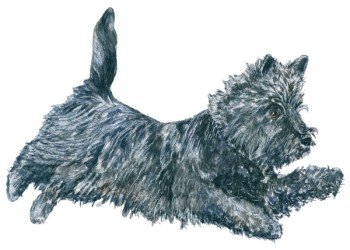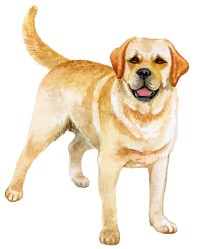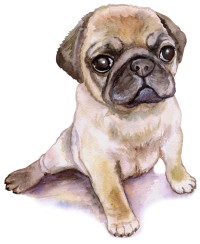Teach Your Pup to be Calm Indoors
By Michele Welton, Dog Trainer, Breed Selection Consultant, Author of 15 Dog Books

Racing around is fine outdoors, but not indoors. Unfortunately this owner isn't helping matters by chasing the pup, which makes the owner just as excitable as the pup himself.
Calmness – both physical and mental calmness – is the foundation for all training.
It's much harder to get good behavior from a pup who is excitable and reactive. By excitable and reactive, I mean a dog who is easily aroused, quick to respond to whatever he sees or hears, and doesn't relax unless he's asleep.
For example, an excitable or reactive dog might:
- race around the house
- play roughly with your other pet(s), wrestling and chasing
- bark when he hears the neighbor's dog bark
- leap on and off the furniture
- bark out the window at people or other dogs
- jump on people
- bark at the TV
- run away from you when you try to get hold of him
- bark at the vacuum cleaner
- run through doors ahead of you
- go cuckoo when you pick up the leash or get his food bowl out of the cupboard
- make so much noise when someone knocks at the door that you find yourself trying to read the person's lips while you're also trying to grab hold of the pup
 Why are some dogs calmer and some dogs more excitable?
Why are some dogs calmer and some dogs more excitable?
Age is a factor – young dogs tend to be more excitable than seniors. Heredity is also a factor – some breeds tend to be more excitable than others.
But excitability is also a learned behavior that has been (unintentionally) encouraged and rewarded by the owner.
For example...
You pick up the leash and your pup barks and leaps with joy. You struggle to attach the leash as he squirms and wriggles. He jumps against the door when you try to open it. Finally it opens a crack and the pup quickly squeezes through and surges past you onto the porch. As you struggle to close and lock the door, the pup is bounding around and pulling on the leash. He spies another dog coming down the sidewalk and lunges forward, barking, his toenails scrabbling on the porch. Yup, time for another "peaceful" walk!
Remember, dogs learn from patterns. They memorize them. If your pup goes crazy and you follow that up with a walk, the pattern you're teaching is: "Go crazy → go for a walk". No, no, no! Excitability should not be rewarded.
Calmness starts with YOU
From a dog's viewpoint, the leader sets the emotional tone for the family group. So interact with your pup in a calm, deliberate manner. Don't rush around, gesture wildly, or grab at him.
Be aware of your body language – it's how canines "read" and draw conclusions about you. Your dog expects a leader to project calm confidence. Deliver that body language and the pup feels satisfied that he had you "pegged" right, which makes him feel more settled and relaxed.
Calm handling can transform an excitable dog
 When I meet a new client, I stand back at first and just observe. Typically their pup will pull on the leash, jump on the owner, bark at whatever, pretty much hyped-up and out of control.
When I meet a new client, I stand back at first and just observe. Typically their pup will pull on the leash, jump on the owner, bark at whatever, pretty much hyped-up and out of control.
Then I approach. I don't speak to the pup or even look at him. As I talk casually with the owner, I reach over and quietly take the leash. I still don't speak to the pup, or even look at him. I just keep talking to the owner and give a leash correction when the pup jumps around with excitability or barks.
Within a minute or two, most dogs stop jumping, stop pulling, stop barking. A minute more, and most dogs are standing or sitting or lying down quietly.
Same dog. And without saying anything to him or plying him with treats.
An excited dog can often be transformed into a more relaxed dog in a matter of minutes, using only confident body language and proper leash communication. Yes, you can use the leash to carry on a "conversation" with your pup.
The first step to indoor calmness and good behavior
My training program (keep reading the articles) will shows you how to stop excitable and reactive behaviors such as barking, rushing the doorbell, jumping on people, pulling on the leash, and dashing through doors and gates ahead of you.
 The FIRST step to indoor calmness and better behavior is to control your pup's movements in the house.
The FIRST step to indoor calmness and better behavior is to control your pup's movements in the house.
One of the biggest mistakes owners make with their dog is giving him too much freedom, too soon.
Being loose in the house should always be a privilege that is s-l-o-w-ly earned – after the pup matures, is 100% housebroken, is calm and quiet, has learned all the rules and routines of your household, and has no behavior issues. All of my well-behaved adult dogs are loose indoors; NONE of my puppies are.
There's no reason that a pup who is new to your household or who has behavioral issues, needs to be wandering around the house. That simply gives him more opportunities to practice undesirable behaviors. Pups who practice undesirable behaviors end up with bad habits.
I limit a dog's movements indoors until:
- he has been in my household for at least 2 months AND is at least 10 months old AND 100% housebroken AND follows all of the routines I've set for my household.
When a dog meets those criteria, I start letting him wander around a few rooms while I'm there to supervise. When he reaches 18-24 months old (and is still well-behaved), I start testing to see if he can be free in the house when I'm gone.
You might think that's a long time to wait. But your pup is going to be with you for 10 to 15 years. Surely you can afford to be ultra-vigilant for a few months, thereby ensuring that all the remaining years will be problem-free.
 How to control your pup's movements indoors
How to control your pup's movements indoors
- If he is not 100% housebroken, he should be in a crate or wire pen whenever you're not interacting with him.
- If he is 100% housebroken, he should be restricted (with portable baby gates) to the same room you're in. Or keep him on a leash so he must follow you around the house as you do chores, or hang out with you while you watch TV or read a book or answer your email. All of which encourages calmness and the right leader-follower relationship.
A pup with a leash on should be supervised at all times so he can't get the leash tangled around anything. Never leave a dog alone with a leash on!
What your pup should do when he's on leash indoors
If you're walking around, he should follow you without pulling on the leash.
If you're sitting down somewhere, place a comfy dog bed on the floor near your feet. Put a safe chew toy like a Nylabone® or Kong® toy on the bed.
Your dog can choose to:
- lie down on the bed or floor
- chew on the toy
- wander around within the length of the 6-foot leash
- or just stand there looking around
- his choice!
Praise good behavior. If he is doing any of the above, give him a quiet, approving "Good boy."
Avoid touching and eye contact. Pups find it harder to relax if you're touching them or looking at them. Stay aware of what your dog is doing, but don't stare at him.
Correct any behavior you don't want repeated, such as:
- Pulling on the leash
- Barking
- Jumping on you or anyone else
- Trying to chase the cat
- Chewing on anything other than his toys
Your job is to set consistent boundaries. "Yes" to this. "No" to that. When your dog sees you doing that, he recognizes that you are the trusted leader and he is the trusting follower.
My best-selling books – now available FREE on my website
 Respect Training For Puppies: 30 seconds to a calm, polite, well-behaved puppy is for puppies 2 to 18 months old. Your puppy will learn the 21 skills that all family dogs need to know. Click here to read for free.
Respect Training For Puppies: 30 seconds to a calm, polite, well-behaved puppy is for puppies 2 to 18 months old. Your puppy will learn the 21 skills that all family dogs need to know. Click here to read for free. Teach Your Dog 100 English Words is a unique Vocabulary and Respect Training Program that will teach your adult dog to listen to you and do what you say. Click here to read for free.
Teach Your Dog 100 English Words is a unique Vocabulary and Respect Training Program that will teach your adult dog to listen to you and do what you say. Click here to read for free. 11 Things You Must Do Right To Keep Your Dog Healthy and Happy helps your dog live a longer, healthier life. Get my honest advice about all 11 Things before you bring home your new puppy, because some mistakes with early health care cannot be undone. Click here to read for free.
11 Things You Must Do Right To Keep Your Dog Healthy and Happy helps your dog live a longer, healthier life. Get my honest advice about all 11 Things before you bring home your new puppy, because some mistakes with early health care cannot be undone. Click here to read for free.
